As a newcomer to coral gardening, Carmen Loke discovers that there is a way to help coral reefs battle for survival – and move from being just a diver to an eco-diver. By Carmen Loke

Gili Trawangan is not just a peaceful getaway, it is into sustainable tourism through the Gili Eco Trust initiatives, which include Biorock restoration and workshops
Gili Trawangan, 15 December 2011. While searching for a location for a women’s conference, I came across an article written by Mallika Naguran from Gaia Discovery about a PADI Biorock® Specialty Course being held in Gili Trawangan (Gili T), Indonesia.
I was intrigued by the programme outline put together by Gaia Discovery and the purpose of the course, which was coral gardening and coral reef restoration using the patented Biorock® process.
Biorock® uses a metal structure charged with around two volts of electricity to help corals re-grow. Coral beds that have been damaged due to storms, global warming, cyanide fishing, dynamite fishing and coral eating predators can be treated, to help restore coral growth near the shorelines, to protect the beach and further erosion problems.
As a Life Coach, I am constantly aware of the purpose of my life and how I choose to help deal with the issues we face on this earth. This was an opportunity for me go and participate with a group that is already creating a pathway and put my diving skills to good use rather than just going on a dive trip to find another manta, whale shark or nudibranch. So, I signed up.
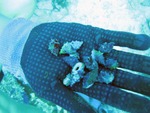
Drupella snails, coral predators hunted out!
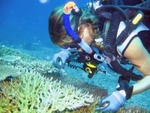
Delphine Robbe goes on a hunt for drupella snails
Ten days before the trip, I thought about how I could involve my friends and thought that it would be interesting for them to help with this adventure. So I created an 11th hour cupcake project to raise funds: 100 cupcakes, each $11 to raise more than $1111.11. I achieved my goal - my poor oven had never worked so hard and the money raised was to be used for issues that I would encounter on the project.
When I arrived on Gili T, I was surprised to find a small eco-village. No motorcars or motorbikes and no dogs. Everyone walked or used a bicycle. The only other form of transport is horse carriage. The outlawing of plastics is ongoing. Disposal of toilet paper is dry, as sewage-based disposal pollutes our sea. Many resorts are non-airconditioned. We stayed in basic accommodation at Big Bubble Dive and Bungalows with compromised water heating system – that meant no heating. Thankfully the days were hot enough for a cool shower.
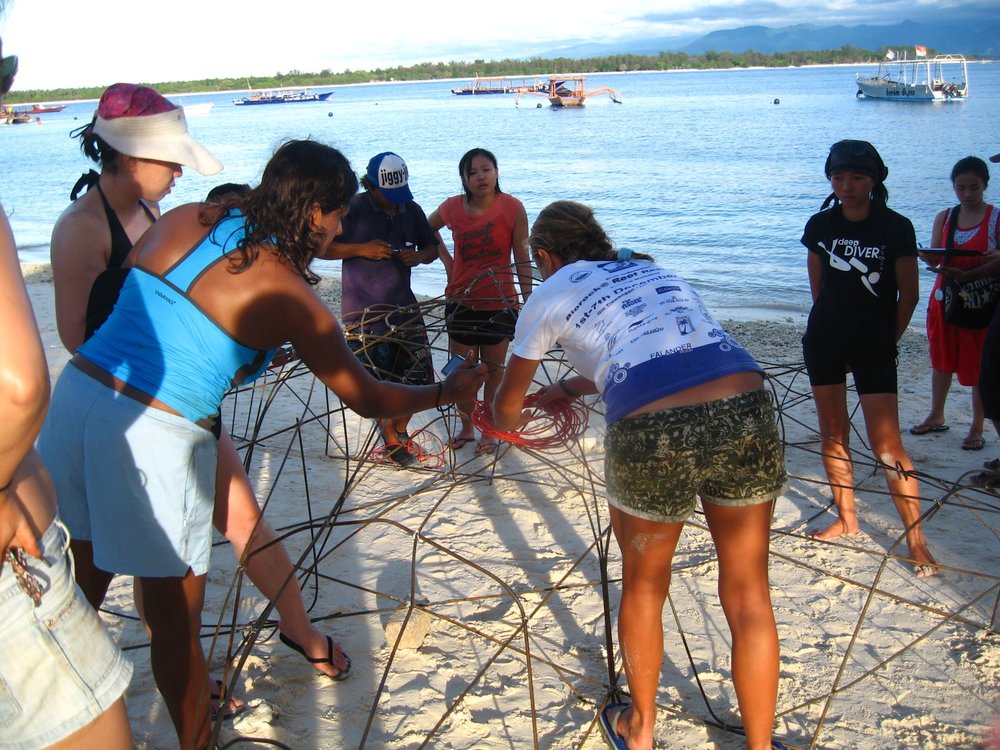
The team works on the bare bones (or bare steel) of the star structure before sinking it to the sea floor
Delphin Robbe was our course instructor and secretariat to Gili Eco Trust. Her expression told us: “You don’t know what you are in for”. Delphin and three other experienced Biorock® specialty divers (Mallika Naguran, Leon Boey of Living Seas and Fiona Childs) guided us and shared so much of their experience in how to build the Biorock® structure.
After some discussion, we decided on a star for our Biorock® design. Bending four metre metal rods was no simple feat, but with proper technique and teamwork, we managed to build the structure in under two hours. It was great that some local villagers and boatmen helped us build our 5 metre wide star - it was a tiring but fulfilling day.
The next morning, we loaded the structure to the boat, with eight divers ready in the water to help lower it to the bottom of the sea. BCD fully inflated, each diver hanging on to each corner of the starfish, we started sinking. The heavy structure pushed everyone down but no one let go. As it hit the bottom of the sea, with precise timing and teamwork, we moved the starfish inch by inch into position.
Then, the coral gardening began. This was an amazing encounter with the life within the corals we had already picked. Almost immediately as the corals were tied onto the structure, fish life started to swim round. They were curious and happily circling around us; it gave me a feeling of being fulfilled and a sense of hope knowing that I had been a part of a new beginning.
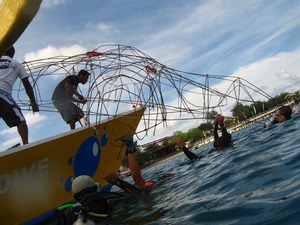
Shaped steel rebars are then transferred to the bottom of the sea
I had one more thing to do. On the trip, there were two trainee dive masters, Vintty Koloay and Made Astawa, both working in Bali. They were invited by Mallika to come and learn about reef gardening and restoration, but had problems getting onboard. If it was not for the sponsorship that Gili Eco Trust and Gaia Discovery gave, they wouldn’t have been there, so I saw the opportunity to use my cup-cake contribution for a partial sponsorship of Vintty’s trip. It was a way to support the local community and to grow the economy through purposeful eco-tourism. I’m glad I could help out.
Gili Eco Trust has really created a little paradise on this earth – many in the city can only speak or hope of a place with no air pollution and little wastage but in Gili they are doing what they love and see creating little miracles everyday. Since 2004 there are more than 60 artificial reef structures lying at the bottom of the ocean, creating a mini barrier reef. They are in the shape of a manta rays, dolphins, and even a sunken handmade motorbike - the Deus, sculptured by Celia Gregory of the Marine Foundation. There are many other similar sites around the world, thanks to Dr Thomas Goreau, the founder of Global Coral Reef Alliance that uses the Biorock® process to grow new healthy coral reefs. Without the Biorock® creators’ vision and passion, they wouldn’t happen.

A clever mix of steel mesh, electricity, and coral seedlings - Biorock can transform a dead zone into a living coral reef
There has been a paradigm shift for me, from being a leisure responsible diver, to being an eco-responsible diver. Ironically, I now have the license to touch! I know which corals are touchable, and how to rescue those being suffocated by pollution. And I look forward to my next trip back to Gili T to see how our star structure has evolved and to do some cleaning.
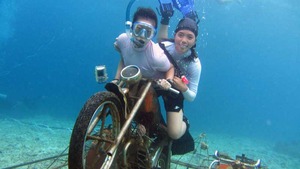
Carmen Loke (front) and Vintty Koloay ride on the Deus, another creative Biorock structure off Gili Trawangan waters
Last but not least, I’m most grateful to my friends, near for being so generous with their donations, out of my mini cupcakes. They have all been my great support and love. I hope that other like-minded divers will undertake this course to better educate themselves and knowing that there is more we can do to help restore our reefs. This was definitely no ordinary dive trip.
Photographs courtesy of Carmen Loke, Fiona Childs, Made Astawa
Visit Carmen Loke's website
Interested in getting a coral reef restoration certification? Contact Delphine Robbe for enquiries.
Gili Eco Trust, Big Bubble Dive & Bungalows and Living Seas were partners of the Gaia Discovery Reef Gardening & Restoration Programme.